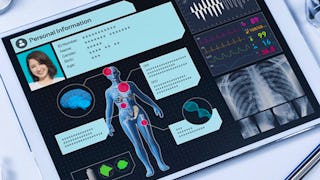This course provides a comprehensive introduction to electrocardiography (ECG), focusing on the principles of ECG interpretation and the recognition of cardiac rhythm abnormalities. Learners will begin by exploring the fundamentals of ECG recording, including lead placement, waveform components, and measurement techniques. Core topics cover the cardiac conduction system, normal sinus rhythm, and common dysrhythmias such as atrial fibrillation, flutter, bradycardia, tachycardia, ventricular arrhythmias, and heart blocks.

Enjoy unlimited growth with a year of Coursera Plus for $199 (regularly $399). Save now.

Electrocardiogram (ECG)
This course is part of Medical-Surgical Nursing: Cardiovascular & ECG Essentials Specialization

Instructor: Rhonda Lawes, PhD, RN
Included with
Recommended experience
What you'll learn
Describe the purpose and basic principles of electrocardiography.
Identify the components of a normal ECG and their relation to cardiac conduction.
Recognize common dysrhythmias and conduction abnormalities on ECG strips.
Discuss appropriate nursing observations and responses to abnormal ECG findings.
Skills you'll gain
Details to know

Add to your LinkedIn profile
October 2025
9 assignments
See how employees at top companies are mastering in-demand skills

Build your subject-matter expertise
- Learn new concepts from industry experts
- Gain a foundational understanding of a subject or tool
- Develop job-relevant skills with hands-on projects
- Earn a shareable career certificate

There are 2 modules in this course
This module introduces students to the fundamental principles of electrocardiogram (ECG) interpretation, providing a systematic approach to analyzing cardiac rhythms. Students will explore the basic components of an ECG strip, including amplitude measurements and the isoelectric line as reference points for waveform analysis. The module emphasizes a step-by-step methodology for ECG interpretation: assessing heart rate and rhythm, analyzing P waves, measuring PR intervals and QRS duration, examining ST segments and T waves, and measuring QT intervals. Students will learn to recognize normal sinus rhythm and understand proper ECG lead placement considerations, including anatomical landmarks for both 5-lead and 12-lead ECG systems. Through this systematic introduction, learners will develop the foundational skills necessary to accurately interpret ECG strips, recognize normal cardiac electrical activity, and prepare for identifying abnormal rhythms in clinical practice.
What's included
14 videos14 readings4 assignments
This module prepares students to identify and understand clinically significant cardiac dysrhythmias and their appropriate management. Students will explore atrial dysrhythmias including atrial fibrillation, premature atrial contractions (PAC), and atrial flutter, learning to distinguish their characteristic ECG patterns and treatment approaches. The module covers paroxysmal supraventricular tachycardia and Wolff-Parkinson-White syndrome, along with their specific management strategies. Students will examine sinus dysrhythmias including bradycardia and tachycardia, life-threatening ventricular rhythms such as ventricular tachycardia and ventricular fibrillation, and their emergency treatments. The module also addresses atrioventricular (AV) blocks from first through third degree, as well as asystole and its management. Through this comprehensive exploration, learners will develop critical ECG interpretation skills necessary to recognize dangerous cardiac rhythms, understand their clinical implications, and respond appropriately in acute care situations.
What's included
23 videos23 readings5 assignments
Earn a career certificate
Add this credential to your LinkedIn profile, resume, or CV. Share it on social media and in your performance review.
Instructor

Offered by
Explore more from Patient Care
 Status: Free Trial
Status: Free Trial Status: Preview
Status: PreviewUniversity of Pennsylvania
 Status: Free Trial
Status: Free Trial Status: Free Trial
Status: Free TrialUniversity of Glasgow
Why people choose Coursera for their career





Open new doors with Coursera Plus
Unlimited access to 10,000+ world-class courses, hands-on projects, and job-ready certificate programs - all included in your subscription
Advance your career with an online degree
Earn a degree from world-class universities - 100% online
Join over 3,400 global companies that choose Coursera for Business
Upskill your employees to excel in the digital economy
Frequently asked questions
To access the course materials, assignments and to earn a Certificate, you will need to purchase the Certificate experience when you enroll in a course. You can try a Free Trial instead, or apply for Financial Aid. The course may offer 'Full Course, No Certificate' instead. This option lets you see all course materials, submit required assessments, and get a final grade. This also means that you will not be able to purchase a Certificate experience.
When you enroll in the course, you get access to all of the courses in the Specialization, and you earn a certificate when you complete the work. Your electronic Certificate will be added to your Accomplishments page - from there, you can print your Certificate or add it to your LinkedIn profile.
Yes. In select learning programs, you can apply for financial aid or a scholarship if you can’t afford the enrollment fee. If fin aid or scholarship is available for your learning program selection, you’ll find a link to apply on the description page.
More questions
Financial aid available,

